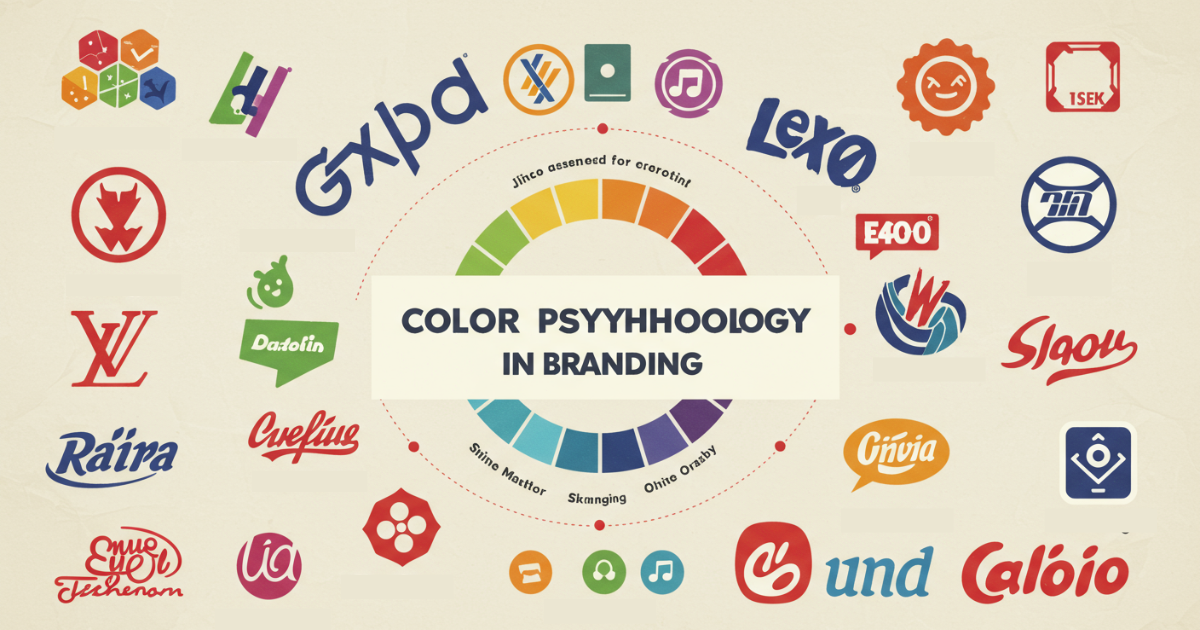Color is not just decoration. It is a strong psychological tool that shapes how people see and feel about your brand. Studies show that customers make quick judgments within 90 seconds, and most of those decisions come from color alone. This is why color plays such an important role in visual identity and emotional branding.
When you understand color psychology in marketing, you can build a better branding strategy. Color theory helps you see how different shades influence mood, trust, and buying behavior. With the right brand colors, you can guide how consumers react to your products, improve brand recall, and create stronger emotional connections.
This guide explains the science behind color perception, how different colors affect consumer behavior, and how you can use these insights in your brand design. Whether you are starting a new business or refreshing your brand, knowing how color influences people will help you stand out, attract customers, and build long-term loyalty.
The Science Behind Color Perception and Brand Recognition

Color perception begins inside the brain, not just the eyes. When light enters the eye, different wavelengths trigger signals that the brain turns into specific emotional and psychological reactions. These reactions influence how people feel, how they think, and how they behave as consumers. This is why color plays such a powerful role in marketing and brand identity.
Humans can recognize around 10 million colors, but the brain organizes these colors into simple emotional meanings. For example, warm colors can signal excitement, while cool colors often create a sense of trust or calmness. Because of this, the colors a brand chooses instantly shape how customers view its personality, values, and reliability.
When consumers see a color connected to your brand, their subconscious mind creates quick judgments. These judgments happen before they even read your message or interact with your product. This is the foundation of consumer psychology and explains why color meaning is so important in branding strategy.
Studies in cognitive psychology show that color can increase brand recognition by up to 80%. This happens because colors act as fast memory triggers, helping people identify your brand in seconds. A strong color palette creates mental shortcuts that make your brand stand out among competitors.
The brain also processes visuals far faster than words—about 60,000 times faster. This means that color becomes your brand’s first language, delivering immediate communication before any text or slogan is seen. In a crowded market, this speed gives brands a powerful advantage.
By understanding how color affects perception, emotional response, and consumer behavior, businesses can create a more memorable, trustworthy, and influential brand presence.
How Different Colors Influence Consumer Psychology
Red: Energy, Urgency, and Action
Red stimulates the sympathetic nervous system, increasing heart rate and creating a sense of urgency. This physiological response makes red particularly effective for call-to-action buttons, sale promotions, and brands targeting impulsive purchases.
Fast-food chains like McDonald’s and KFC leverage red’s appetite-stimulating properties, while brands like Coca-Cola use it to convey energy and excitement. However, red can also signal danger or aggression, so context matters significantly.
Blue: Trust, Security, and Professionalism
Blue activates the parasympathetic nervous system, promoting feelings of calm and security. This makes it the most popular color choice for financial institutions, technology companies, and healthcare brands seeking to establish trust.
Facebook, IBM, and PayPal all use blue to convey reliability and professionalism. Research indicates that blue can also enhance productivity and focus, explaining its prevalence in corporate environments.
Green: Growth, Nature, and Wellness
Green represents balance, harmony, and natural health. It’s processed most easily by the human eye, reducing eye strain and creating a sense of relaxation. Brands in the health, wellness, and environmental sectors frequently choose green to communicate their values.
Whole Foods, Spotify, and Starbucks use various shades of green to suggest freshness, growth, and environmental consciousness. Green also has strong associations with money and prosperity in Western cultures.
Yellow: Optimism, Creativity, and Attention
Yellow stimulates mental activity and generates feelings of happiness and optimism. It’s the most attention-grabbing color, making it excellent for highlighting important information or creating memorable brand experiences.
Brands like IKEA and Best Buy use yellow to convey friendliness and accessibility. However, excessive yellow can cause anxiety, so it’s often paired with more grounding colors in brand palettes.
Cultural Considerations in Color Psychology
Color meanings vary significantly across different cultures and geographical regions. What represents purity in one culture might symbolize mourning in another, making cultural sensitivity crucial for global brands.
Western Color Associations
In Western cultures, white is typically associated with purity and cleanliness, making it a popular choice for healthcare and luxury brands. Black conveys sophistication and premium quality, which explains its dominance in the high-end fashion and technology sectors.
Eastern Color Interpretations
Eastern cultures often assign different meanings to the same colors. Red symbolizes luck and prosperity in China, making it highly desirable for brands targeting Chinese consumers. White, however, can represent death and mourning in some Asian cultures.
Regional Market Adaptations
Successful global brands adapt their color strategies to local markets. For example, McDonald’s uses green instead of red in several Middle Eastern countries to align with cultural preferences and religious sensibilities.
Implementing Color Psychology in Brand Strategy
Defining Your Brand Personality
Before choosing your brand colors, you must define your brand personality and understand your target audience. Ask simple questions:
Are you energetic and innovative, or calm and trustworthy? Your color choices should match these traits and support your overall brand identity across every touchpoint. This helps you maintain strong brand consistency and clear brand perception.
Create detailed buyer personas that include demographics, culture, preferences, and behavior patterns. This type of market research helps you pick colors that feel natural to your audience and fit their psychological expectations. It also strengthens emotional branding by aligning color psychology with customer values.
Creating Effective Color Combinations
A strong brand palette usually contains 2–4 colors that work well together. Use basic color theory—like complementary, analogous, or triadic schemes—to create a balanced and professional look. These combinations improve your visual branding and make your brand more recognizable.
Let your primary colors define your main brand experience. Secondary colors should be used as accents to support flexibility in your digital design, packaging, and marketing materials. Always maintain enough contrast to ensure accessibility and readability across all formats.
Testing and Optimization
Testing your color choices is important for understanding real consumer behavior. Run A/B tests to compare different color variations across websites, ads, social media content, and product packaging. This helps you identify which color combinations improve engagement and support your branding strategy.
Track performance metrics such as click-through rates, conversion rates, user interaction, and brand recall. These insights reveal how effectively your color palette influences customer decisions. Use this data to refine your color choices and create a more powerful, data-driven color psychology approach.
Common Color Psychology Mistakes to Avoid
Many brands repeat simple mistakes when using color psychology. These errors weaken their color strategy, affect consumer perception, and reduce overall marketing impact.
Ignoring Target Audience Preferences
Some brands choose colors based on personal taste, not audience needs. This creates a gap between your brand identity and what customers expect. Always consider your audience’s culture, age, emotions, and buying behavior when selecting colors.
Inconsistent Color Application
Using different shades across platforms hurts brand recognition. Consistency is important for trust and visual branding. Create clear brand guidelines that include color codes, usage rules, and examples for every touchpoint.
Overcomplicating Color Palettes
Too many colors make your brand look messy and confusing. Keep your main palette simple with only 2–3 primary colors. Use accent colors only when needed to support key design elements.
A strong color strategy helps maintain clarity, improve user experience, and support long-term brand growth.
Measuring the Impact of Color on Brand Performance

Tracking the effectiveness of your color psychology implementation requires both quantitative metrics and qualitative feedback.
Quantitative Metrics
Monitor conversion rates, engagement rates, and brand recognition scores before and after color changes. Use heat mapping tools to understand how different colors influence user behavior on your website and digital platforms.
Track sales performance across different color variations of products or promotional materials. This data provides concrete evidence of color psychology’s impact on purchasing decisions.
Qualitative Assessment
Conduct surveys and focus groups to gather consumer feedback about your brand colors. Ask specific questions about emotions, associations, and brand personality perceptions triggered by different color combinations.
Social media sentiment analysis can reveal how consumers respond to your color choices in real-world contexts. Monitor comments, reviews, and brand mentions for feedback related to color.
The Future of Color in Brand Marketing
Color psychology is changing as technology grows and customer behavior evolves. Brands need to follow new trends, research, and design insights to stay competitive.
Digital screens, AR tools, and interactive visuals now allow brands to use dynamic colors. A brand can change its color tones based on time, environment, or user preference. This creates personalized experiences and improves visual branding.
Sustainability is also shaping color choices. Many companies now prefer earth tones, natural shades, and calm palettes to show eco-friendly values. These colors help build trust and support stronger brand identity, especially among conscious consumers.
These changes show how important color has become in brand in marketing. The right colors can improve customer perception, emotional connection, and brand recognition.
To stay ahead, brands should review their current color strategy. Check how your colors influence audience emotions, user experience, and overall brand presence. Then make improvements using simple design principles and insights from color psychology.
A strong and consistent approach to color helps every brand communicate clearly, attract the right audience, and create long-term impact.
FAQs
1. Why is color psychology important for branding?
Color psychology helps brands influence emotions, shape perceptions, and improve brand recognition. The right colors can attract attention, build trust, and guide consumer decisions.
2. How do colors impact consumer behavior?
Different colors trigger different psychological responses. For example, red creates urgency, blue builds trust, and green promotes calmness. These emotional reactions influence buying decisions and brand preferences.
3. Can color really increase brand recognition?
Yes. Studies show that consistent color use can boost brand recognition by up to 80%. Colors act as visual shortcuts that help customers instantly identify your brand.
4. Do color meanings change across cultures?
Absolutely. Color interpretations vary by culture. For example, red symbolizes luck in China but urgency in Western markets. Understanding cultural differences is essential for global branding.
5. How many colors should a brand palette include?
Most effective brand palettes use 2–4 core colors. Too many colors create confusion, while a focused palette strengthens consistency and brand recall.
6. How can I test if my brand colors are effective?
Use A/B testing, heatmaps, surveys, and feedback to measure user responses. Monitor metrics like click-through rates, conversions, and customer sentiment to evaluate color performance.




